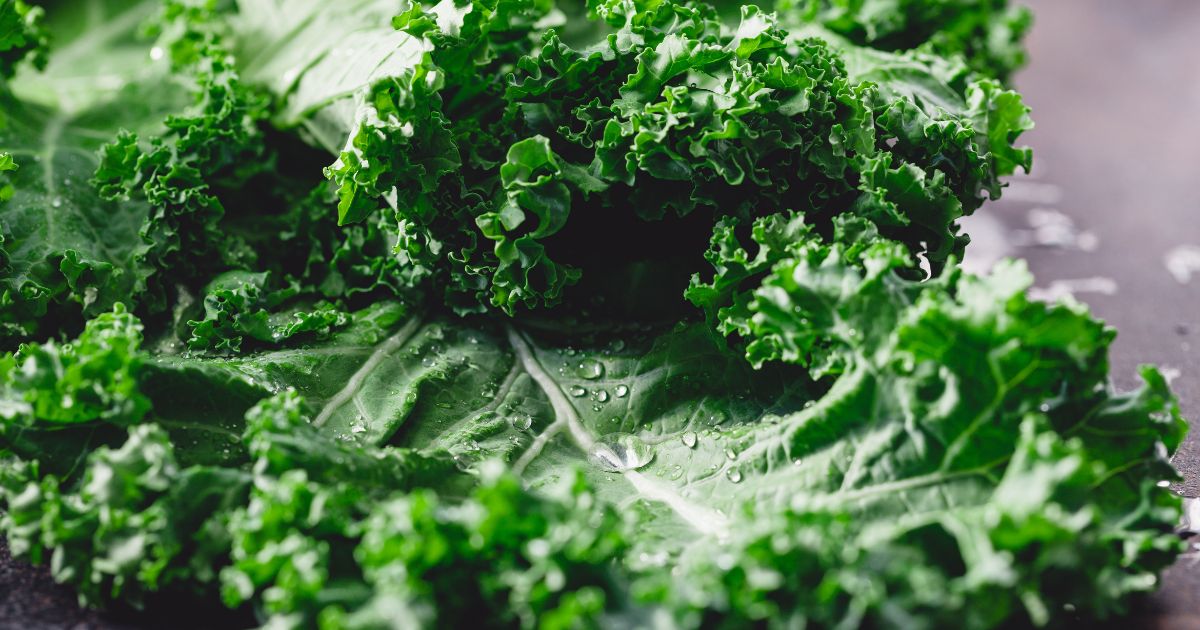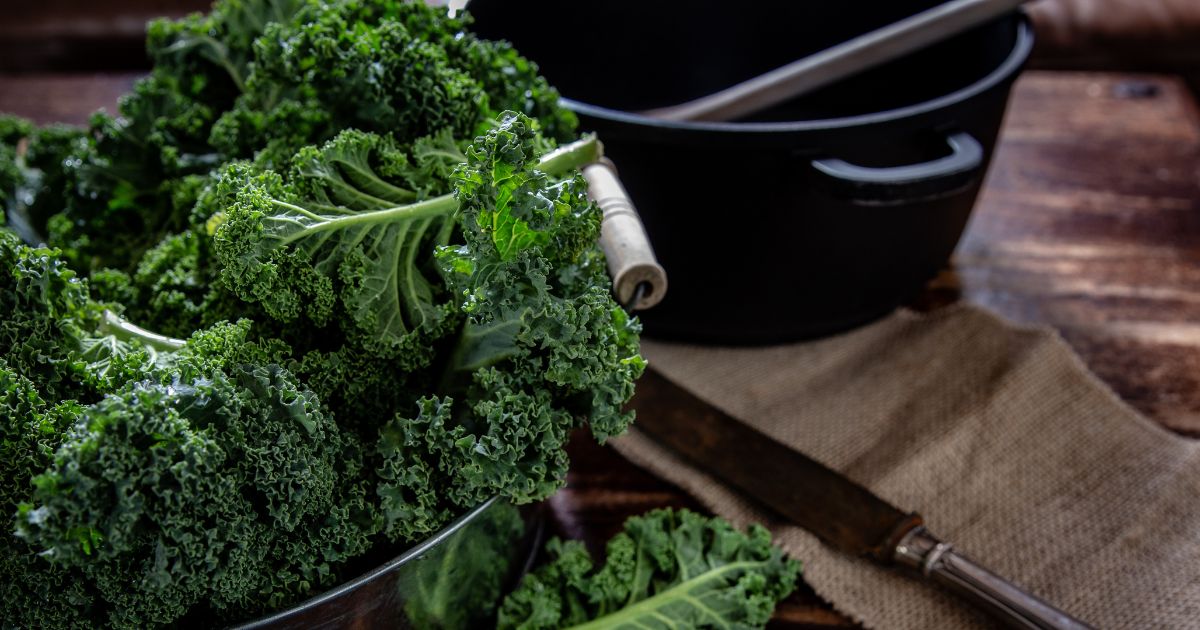Introduction
Kale, often hailed as the ‘queen of greens,’ has long made headlines in health and nutrition. This green, leafy, powerhouse isn’t just flavorful, it’s also a nutrient-dense superfood with a long list of potential health benefits.
Widely regarded as one of the most nourishing foods on the planet, kale is a hearty, versatile, and delicious vegetable that fits perfectly in salads, soups, or even as a healthy snack when baked as chips.
Why You Should Consider Adding Kale To Your Diet
There are plenty of reasons to make kale a regular co-star of your meals. Apart from its impressive nutrient lineup, it blends well with many different dishes.
It’s also packed with dietary fiber, which promotes digestive health. Kale is also a good source of prebiotic carbohydrates that feed the “good bacteria” in your gut, and it’s very low in calories.1
The King Of Greens: Nutritional Profile Of Kale
Vitamin And Mineral Burst: Unpacking Kale’s Magic
Kale boasts a remarkable list of vitamins and minerals that contribute to its nutrient-dense status and provide various potential health benefits.
One cup of this green wonder includes such superstars as:
- Vitamin K – 68% of the daily recommended amount (DV)
- Vitamin C – 22% of the DV
- Manganese – 8% of the DV
- Vitamin A: 6% of the DV
- Riboflavin: 5% of the DV
- Calcium: 4% of the DV 2
Kale also includes smaller amounts of folate, vitamin B6, potassium, magnesium, and iron.
On top of this, kale contains powerful antioxidants, like quercetin and kaempferol, omega-3 fatty acids, and famed carotenoids lutein and zeaxanthin.3,4
Kale: A High-Fiber, Low-Calorie Wonder
As a member of the cabbage family, kale stands out for being a wonderfully high-fiber, low-calorie food. It’s become a go-to ingredient for those concerned about supporting weight management. With a humble 7 calories per cup, kale can deliver a hearty portion and help promote feelings of fullness.
Kale provides around 1 gram of fiber per serving, more than a slice of bread. Fiber is crucial for supporting healthy digestion and promoting regular bowel movements.5,6
In essence, kale is one mighty leaf.
A Multitude Of Potential Health Benefits

Supporting Digestive And Heart Health With Kale
Kale is a friend of the digestive system because it’s high in fiber. Dietary fiber affects many functions of the digestive system – from the rate of digestion to the absorption of nutrients, and the movement of waste through the colon. It also provides food for friendly gut bacteria. Fiber also adds bulk to the stool, ensuring a smooth transit.7
Heart health is another area where kale shines. It contains several heart-friendly nutrients, like potassium and dietary fiber.
Potassium helps the body process extra salt while also helping to relax blood vessel walls, which can help support healthy blood pressure. The American Heart Association recommends increasing potassium intake to help promote healthy blood pressure and overall heart health.8
The fiber present in kale may also have a positive impact on heart health. One study found that consuming more fiber resulted in lower blood lipid levels and reduced blood pressure.9
Kale As Brain Food: Supporting Mental Focus
The nutrients in kale aren’t just good for your body, they’re beneficial for your brain, as well. Leafy greens, including kale, are packed with brain-healthy nutrients, like vitamin K, lutein, folate, and beta-carotene, which may help support brain health.10
Kale also contains omega-3 fatty acids, an essential fatty acid that supports brain health.
Research suggests that omega-3 fatty acids can enhance the health and function of the brain. In fact, brain cells with higher levels of omega-3 are thought to be better at communicating with other cells as part of the brain’s function.11,12
Kale also contains folate and iron, both of which are crucial for optimal brain health and function.13,14
Putting Up A Fight: How Kale Helps Support Your Immune System
The nutrient profile of kale may also provide immune system support. Packed with a wealth of vitamins, minerals, and antioxidants, kale may fortify the body’s defenses.
Vitamin C found in kale is known for its immunity-boosting properties. An increased vitamin C intake can enhance immunity by supporting cellular functions and promoting the production of white blood cells.15,16
While potent antioxidants found in kale can offer protection against oxidative damage caused by free radicals.17
Cooking With The Green Giant: Top Kale Recipes
Meal Ideas: Serving Suggestions For Kale
Whether cooked or eaten raw, kale can introduce flavor and texture to a meal, making it one of the most versatile leafy greens available. Here are a few great ways to integrate this leafy green:
Kale Salads: Want to make your salads more interesting? Swap out the usual lettuce for raw kale. To make it easier to digest and enhance its flavor, massage the kale leaves with a bit of olive oil before adding your favorite ingredients.
Sautéed Kale: Sautéing kale with garlic and onions in olive oil until they’re soft makes it an excellent side dish. Alternatively, steam the kale for five minutes, drain, and add a dash of soy sauce and tahini to enhance its flavor.
Kale Chips: Making kale chips is as simple as removing the ribs, coating the leaves in olive oil, and sprinkling on your choice of spices. Bake them at 275°F for 15–30 minutes until they achieve the desired crispness. They’re delicious!
Smoothies: An easy way to add nutrients to your breakfast or snack time is by adding kale to your smoothie. It will not only make the diet healthier, but it won’t change the flavor of the smoothie.
You could also add kale to your favorite dip, turn it into pesto to top your pasta, add it to risotto, or replace spinach in lasagna or egg dishes.
These are just a few examples of how you can incorporate kale into your meals. The opportunities to experiment with this nutritious green are endless.

Preparing Kale For Maximum Nutrient Intake
When it comes to getting the most out of this hardy green, how you prepare it matters. Here are a few tips to ensure you’re maximizing the nutritional benefits of kale:
- De-stalk before cooking: Before cooking kale, remove the tough central stalk. This part of the leaf can be difficult to digest.
- Massage raw kale: If you’re planning to eat kale raw in a salad, massage the leaves first with a bit of olive oil and a pinch of salt. This helps to break down the structure and makes it easier to chew and digest. It also mellows the flavor of the kale.
- Use the right cooking method: To retain the maximum amount of nutrients when cooking kale, the healthiest methods include steaming, sautéing, or cooking it in soups where you can consume the cooking liquid. Boiling kale can leach out some of its nutrients.
- Store it properly: Store your kale in the refrigerator in a plastic bag. This will keep it fresh and crisp for about a week.
Powdered Kale Nutrition
Powdered kale is made by dehydrating and grinding fresh kale leaves into a fine powder. It’s an easy new way to consume this nutritional powerhouse. It’s packed with essential vitamins, minerals, antioxidants, and fiber – just like whole-leaf kale – and it offers a convenient way to incorporate kale into your diet.
This vibrant green powder can easily be added to smoothies and soups or sprinkled over dishes, making it an excellent choice for those looking to boost their nutritional intake without the hassle of fresh preparation – no more kale chunks in that protein shake!
The Takeaway
Getting Your Dose Of Kale: Daily Recommendations
While there isn’t an established daily recommended intake for kale, many nutritionists advise incorporating a wide range of fruits and vegetables into your diet, with an emphasis on green leafy vegetables, like kale.
Dietary guidelines suggest that adults should eat 1 ½ to 2 cups of dark green vegetables each week. In this case, Kale can make up a substantial part of this, considering its nutrient-dense profile.18

The Mighty Leaf’s Role In A Balanced Diet
As a high-fiber superfood, kale contributes to gut health and aids in digestion. It acts as a potent source of antioxidants and may help promote cardiovascular health and boost the immune system.
Its low-calorie, high nutrient content makes it an excellent addition for those aiming to support weight management.
And, when incorporated with a variety of other colorful vegetables, lean proteins, whole grains, and healthy fats, kale contributes significantly to a balanced plate. Kale’s versatility in recipes makes it easy to enjoy in a diverse array of meals.
So, consume kale regularly, as part of a varied and balanced diet, and help support your whole-body health in the process.
Sources
- https://www.ncbi.nlm.nih.gov/pmc/articles/PMC8782012/
- https://www.healthline.com/nutrition/10-proven-benefits-of-kale
- https://www.ncbi.nlm.nih.gov/pmc/articles/PMC3705341/
- https://fdc.nal.usda.gov/fdc-app.html#/food-details/174924/nutrients
- https://health.cornell.edu/sites/health/files/pdf-library/fiber-digestion-health.pdf
- https://www.heart.org/en/healthy-living/healthy-eating/eat-smart/sodium/potassium#:~:text=Most%20women%20should%20get%202%2C600,overall%20heart%2Dhealthy%20eating%20pattern.
- https://www.cochranelibrary.com/cdsr/doi/10.1002/14651858.CD011472.pub2/full
- https://www.health.harvard.edu/healthbeat/foods-linked-to-better-brainpower
- https://www.hsph.harvard.edu/nutritionsource/2007/06/19/ask-the-expert-omega-3-fatty-acids/#:~:text=There%20are%20two%20major%20types,%2C%20spinach%2C%20and%20salad%20greens.
- https://www.alzheimers.org.uk/about-dementia/risk-factors-and-prevention/omega-3-and-dementia#:~:text=Omega%2D3%20is%20important%20for,important%20process%20for%20brain%20function.
- https://journals.plos.org/plosone/article?id=10.1371/journal.pone.0287703
- https://www.sciencedirect.com/science/article/pii/S0002916523297373?via%3Dihub
- https://www.ncbi.nlm.nih.gov/pmc/articles/PMC5707683/
- https://www.hsph.harvard.edu/nutritionsource/vitamin-c/#:~:text=Vitamin%20C%20and%20Health,activity%20of%20white%20blood%20cells.
- https://www.cancer.gov/about-cancer/causes-prevention/risk/diet/antioxidants-fact-sheet#:~:text=Antioxidants%20are%20chemicals%20that%20interact,antioxidants%20are%20called%20end
- https://pubs.nmsu.edu/_e/E139/index.html#:~:text=Dark%20green%20leafy%20vegetables%20are,dark%20green%20vegetables%20each%20week.

